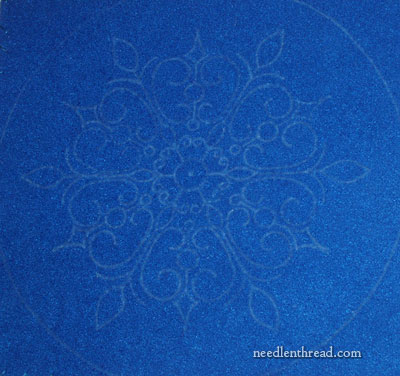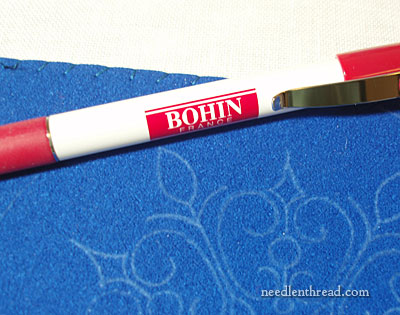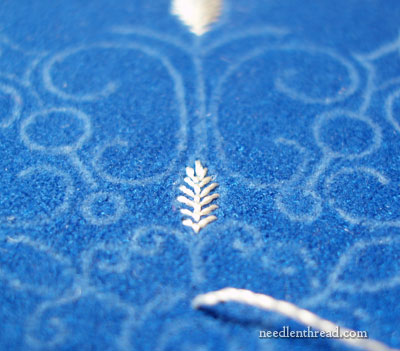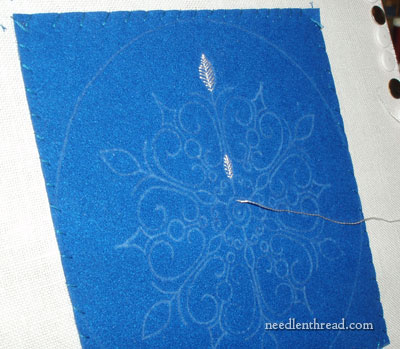The snowflake project I’m working on right now is really a test project in a number of ways:
First, I want to try this silver real-metal thread.
Second, I want to feel out the difficulties of stitching on a “suede” fabric (synthetic suede).
Third, I want to test my sanity: what will happen to my mental state if I add another project to the queue?

The synthetic suede that I’m embroidering on is a beautiful color of blue, but it’s hard to capture it in photos. What will look right on my monitor might look perfectly ghastly on yours, so don’t trust the color of the photo above – trust me instead! It’s a beautiful blue.
But – it is synthetic. And it has that weird suede-y finish on both sides. So why am I stitching on it? I want to test this fabric for hand embroidery purposes, because I have it in mind for a later project. The fabric cuts well, with a clean finished edge (no unraveling or anything) and it could be quite nice in certain appliqué situations. I’ll tell you more about this stuff later, if it works out, and when I’ve had a chance to really work with it. It’s not something I’d whole-heartedly recommend for hand stitchery unless I’m really convinced it’s going to work well, with a reasonable assurance of successful results. And I’ve not done enough on The Flake to be 100% convinced of that.

When you’re looking head-on at the design transferred onto the blue, you can’t really see it that well. Check out the difference between the lines you can see in the first photo, and the lines you can see in the photo immediately above. Depending on the angle at which you view the piece, the lines are more or less clear.
After pouncing the design onto the blue, I used a white ceramic Bohin pencil to draw in the lines. This works fine for getting the lines onto this kind of fabric – they’re clear enough, and it’s easy to draw with the ceramic pencil, but unfortunately, the ceramic lead has very little staying power on the suede. The slightest rub, and the marks are gone. I thought about painting over the lines, but on this type of design, which is meant to look airy and open in many parts, permanent lines would not be helpful.
The only thing for it: be careful of the lines!

For the main filled areas, I’ll be using open, light stitches, like the fly stitch in the photo above. Stitching on pseudo-suede is perhaps not the easiest thing in the world to do. I suppose it’s not as bad as it could be, but it’s not “easy” – it takes some manipulation with the needle, and it definitely requires a thimble.
It’s difficult to see exactly where the needle is going to come up through the fabric. Although you do get that initial “bump” of the needle pushing on the fabric from behind, this doesn’t necessarily indicate precisely where the needle will emerge. Sure, it’ll come up somewhere in that pressure bump, but not necessarily exactly where you want it. It makes the stitching process a little slow, but it may be just a matter of getting used to it. By the time I got halfway around the snowflake filling in these little areas, the speed was picking up a bit.

Looking from the side, the design is fairly clear, but there’s not much stitching progress to behold!
I’ve mounted the suede on a piece of linen in an Evertite frame, so I’m stitching through both layers. The suede needs a support fabric behind it, especially for the metal threads – it’s a relatively thin piece of fabric, but it’s tough. Very tough!
As soon as I finish up these filled areas, I can test the silver thread on this. I’ll let you know how that goes.
Oh, and as for my mental state, I find it’s not much different from usual. And you can take that however you wish!
Enjoy your weekend!







Mary, are you using a leather needle? While I’ve not tried embroidery on faux suede, I do use faux suede at times and either on the machine or had stitching find a leather needle helps with speed and accuracy. Just an idea. HTH. Jane
Hi, Jane – No, I’m not. I don’t have one that’s small enough, and I couldn’t find any locally. So for now, I’m using a regular needle. If I can get ahold of one that is small enough, I’ll give it a try! Thanks for the suggestion! ~MC
Just to jump into that conversation – you can use a glover needle. It has the knife-edge wedge of a leather but is finer and smaller, since it is made for kidskin. It is relatively easy to find, too, usually sold in packets of specialty needles like curved, blunted, and glovers.
Hi, all – Thanks for the tips on the needles!
I ordered some glover’s needles early this week, hoping that the smallest size might work. They should be here at the beginning of next week.
This particular synthetic suede is not as difficult to pierce as others I’ve tried, though – and it’s not nearly as difficult to work on as leather! That being said, it isn’t cotton, either! So the thimble really helps, and I’ll try the glover’s needle to see if it makes a difference.
Thanks, Gail, for your offer! I appreciate that! We’ll see how the ones I ordered work out – I think they’re the smallest of this type of needle available, so here’s hoping…
~MC
I have a pack of leather needles, sizes 3, 5, 7. The smallest one *might* work. If you’d like them to try, they’re yours. Or let me know what size needle you are using, I can compare them.
I’ve never worked with faux suede, so I don’t know if my trick would work, but I did some beading work on real suede and something that helped me was to use two needles: one with the thread and beads, of course, and the other one to poke the hole where I want my threaded needle to go through coming from the back. With the needle still in the hole, I’d feel from the back where it is and align the threaded needle right next to it. Then I’d remove the “awl” needle and bring the threaded one through the hole.
Mary – How about backing it with a tear away interfacing (like those for machine embroidery) or something like Sulky Solvy that washes away. You would have a bit of something to keep the fabric from crawling or resisting the needle on the underside and still keep the hand of the fabric afterwards.
Or – maybe try attacking the design from the underside like tambor work. I love to do work like this with a thin metal crochet hook that’s been sharpened to a point at the end; I hear those can be purchased now but my husband files mine for me.
You seem to be like me – I turn the simplest project into a monster because I can’t just to something simple!
Good luck!
Cathy
Sometimes, I want to try to embroider on the felt, for example to decorate Christmas cards, but I confess that I never dared to try. And what I read here on the suede fabrik that looks more “consistent” than felt does not reassure me. Yet this silver thread on blue suede looks very nice.
(sorry for my poor english)
Hi-Mary, Just a thought about using a wedge tip needle- it doesn’t leave a small hole like a standard needle. It actually knife-cuts a corner slit into the fabric. If you use a skin, or skin-like cloth, the cloth sort of “self-heals” and the cut is invisible. However, be cautious that this does not chop up your cloth where you need to place close together stitches.
Hi Mary, I love this blue; it is my favourite colour and it just looks so divine with the silver. Sadly I have no clever tricks for sewing on synthetic suede although I am eagerly reading what others have to say since I use it occasionally in crazy quilting.
I do however have a question about using ‘real’ silver thread: in pictures of very old embroideries made with silver thread the silver is black with tarnish. Will this happen with your new modern hopefully ‘improved’ silver thread and if it does how would you go about cleaning it?
babulle – embroidery on felt is easy, perhaps easier than “normal” embroidery fabrics. While it can be a bit thicker, it’s just a mass of fibers smooshed together, with no backing threads to worry about getting a needle through in just the right spot. Synthetic suede is a very fine, dense knit with a brushed surface, if I recall correctly. And that base fabric is tough to get a needle through.
I’ve used faux suede for applique. I am intrigued by the negative/positive one-cut series in Ostaus 1561 modelbook: http://www.cs.arizona.edu/patterns/weaving/books/og_lace.pdf (starting around pattern #35 or so and intermittently thereafter). I made a strip mock up and carefully cut, separating the two pieces so that both could be appliqued. But I ended up being very disappointed.
The stuff stretches mightily. I should have backed it on some heavier stabilizer than I used because I was unable to achieve neither the precision symmetry of the cut I was looking for, nor a uniform appearance after applique. YMMV.